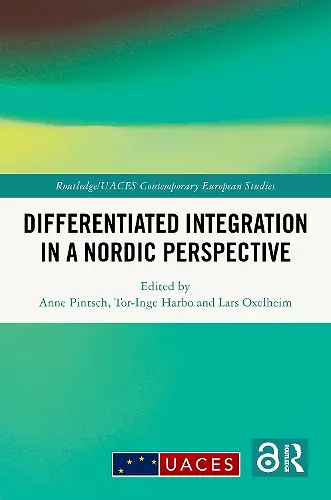Differentiated Integration in a Nordic Perspective
Lars Oxelheim editor Anne Pintsch editor Tor-Inge Harbo editor
Format:Hardback
Publisher:Taylor & Francis Ltd
Published:13th Feb '25
£145.00
Supplier delay - available to order, but may take longer than usual.

This book analyses differentiation in European integration from a Nordic perspective.
Following an interdisciplinary approach and focusing on the idea of the Nordics as a laboratory of differentiation, the book explores specific Nordic concerns in policy fields such as the labour market, security and Justice and Home Affairs (JHA), EU institutions such as the European Commission and the Eurogroup, and legal issues such as the European Economic Area (EEA) law and European patent law. It discusses differentiation, particularly from the Nordic experiences, examines the lessons that can be learnt from them, and suggests more 'hidden' and less researched cases.
This book will be of key interest to scholars and students of European studies, European integration, Nordic studies, differentiated integration and more broadly to comparative politics.
Chapters 5, 6, and 9 of this book are freely available as a downloadable Open Access PDF at http://www.taylorfrancis.com under a Creative Commons Attribution-Non Commercial-No Derivatives (CC-BY-NC-ND) 4.0 license.
“Understanding differentiation in the European Union requires an in-depth look at the Nordic region, which has been experimenting with new modes of cooperation over the past decades. This timely volume offers fresh insights into the matter, by examining diverse policy areas - from economic and social issues to politics, administration, and law. This makes it essential reading for scholars and practitioners interested in the future of European integration, especially in light of the ongoing challenges that may require more flexible forms of cooperation.”
Benjamin Leruth, The University of Melbourne, Australia
“500 years after the dissolution of the Kalmar Union, the five Nordic countries are yet again united in one and the same defence union, due to Finland’s and Sweden’s accession to NATO. This is promoting further and future Nordic integration in other areas. It is also helpful to the fulfilment of the vision of the Nordic heads of government that the Nordic region should be the world’s best integrated region by 2030. However, my work as Sweden’s representative in the Nordic Council of Ministers’ Freedom of Movement Council shows that much remains to be done to fulfil the vision, not least to fully integrate the Nordic labour markets. The evolution of Nordic differentiation after World War II contains several significant lessons that are of importance to further Nordic integration, as shown in this valuable volume. Thus, it is also highly relevant for the next steps towards a better, or even fully, integrated Nordic region, as well as to integration processes elsewhere.”
Anders Ahnlid, Director-General of National Board of Trade, Sweden
ISBN: 9781032691015
Dimensions: unknown
Weight: 620g
236 pages